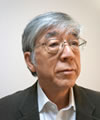Cutting-Edge Research
in Kyoto University
SEISMOL
Earthquake Cycle Simulation Computer simulation of past and future earthquakes.

Two oceanic plates are subducting at a rate of several centimeters per year beneath northeast and southwest Japan (see illustration). Due to friction, some parts of these plate interfaces can stick together for a hundred years or more. When such plates suddenly slip, it can produce earthquakes of magnitude eight or more, causing severely destructive ground shaking and tsunamis, such as the 2011 Tohoku earthquake and tsunami disaster. Such iterative stick–slip processes are called “earthquake cycles.” I am engaged in studies using a supercomputer-constructed model of the Japanese islands which simulates such earthquake cycles based on a laboratory-derived friction law to reproduce the occurrence of historical severe earthquakes in order to predict the occurrence of earthquakes in the future. My work is particularly concerned with the impending Nankai earthquake in southwest Japan, which is anticipated to occur in the first half of this century.

- Kazuro Hirahara, PhD
- Professor,
Graduate School of Science
